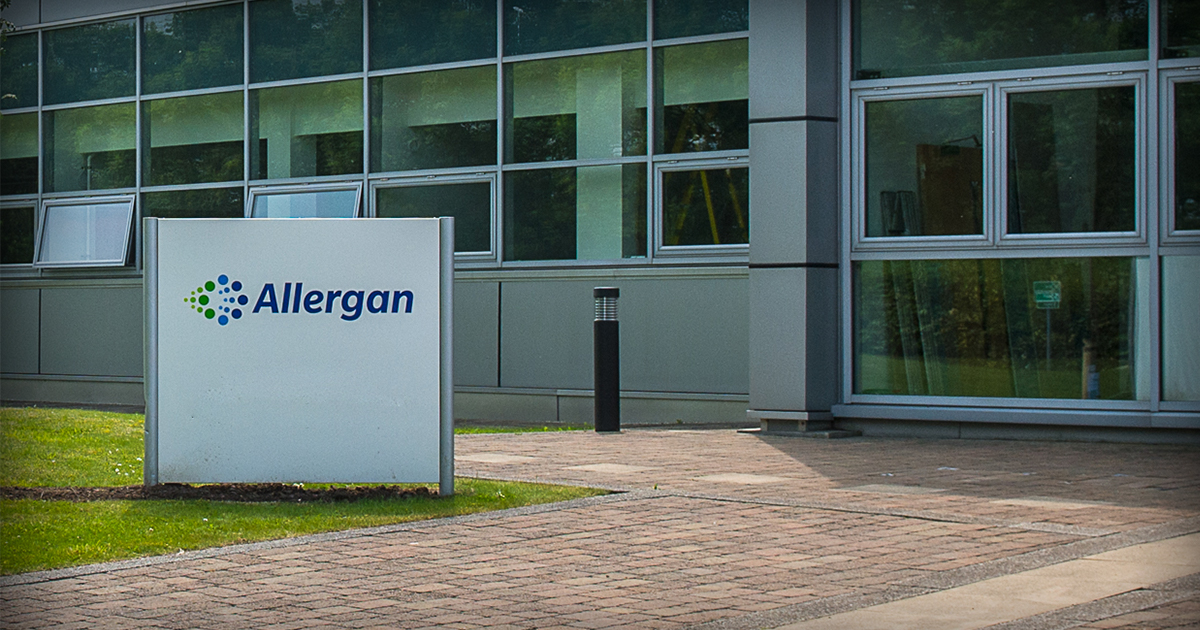Allergan Ready for a Future of Generic Competitors

At the 36th annual JP Morgan Healthcare Conference in San Francisco, Allergan CEO Brent Saunders said a disconnect exists between the company’s 2017 results and its stock price. Even though the stock Monday closed about 25% below its one-year high, he told the JPM attendees that Allergan stock is undervalued, mostly due to the loss of exclusivity on Restasis, and an underappreciated R&D pipeline.
In giving his 2018 outlook for the company, Saunders said he’s still very optimistic, due to a durable and growing base business, and a sound strategy and deep pipeline in each of its four key therapeutic areas. “I believe the true value of our business will become more obvious to our current and future investors and will be better reflected in our stock price,” he predicted of 2018.
Mitigating Loss of Exclusivity
Saunders discussed Allergan’s plan to mitigate the financial impact of the products facing loss of exclusivity (LOE), including Restasis, while protecting the company’s underlying growth profile, margins, and cash flow. He also pointed out that a number of important R&D programs would be producing readouts in 2018.
He characterized the company’s cash flow as “very healthy and durable” despite the LOEs, and that it is well on its way to reaching its priority goals of reducing leverage to a target of three times gross debt to EBITDA (earnings before interest, tax, depreciation, and amortization) and maintaining investment-grade ratings. Allergan has also made progress, and will continue to be opportunistic, on a $2-billion share buyback, and is committed to growing the dividend for stockholders annually.
Saunders said that although total sales and growth will be impacted by the LOEs in the next 12 to 24 months, the underlying core business, which represents about 80% of total revenues, is growing at a mid-single-digit rate. Longer term, the revenue growth outlook is solid, he said, adding, “On a risk-adjusted basis we believe our total business will grow approximately 5% annualized between 2017 and 2022, with our pipeline more meaningfully contributing to revenues at the back end of this period.”
Cost-cutting Moves
He also noted that while the LOEs will impact near-term margins, Allergan will be executing cost-cutting initiatives to partially buffer the impact. “In order to manage through the LOEs, we are restructuring our cost base, and reducing operating costs by $300 to $400 million relative to 2017 full-year operating expense,” Saunders told the JPM gathering.
Those cost-cutting actions will not be applied evenly across the organization. Some areas will see cuts while other areas will see increased investment, especially the key long-term growth drivers, he said. A recent Securities and Exchange Commission filing reveals one of those cost-cutting initiatives: to eliminate 1,400 jobs and take a one-time charge of about $125 million.
At JPM, Saunders went into detail discussing the company’s four main therapeutic areas: eye care, medical aesthetics, central nervous system (CNS), and gastrointestinal (GI). For the purposes of OIS Weekly, we’ll concentrate on eye care.
Saunders said Allergan’s eye-care business has been anchored by Restasis for dry eye for many years, but that even without Restasis the sector for the company remains very strong, generating $2 billion in business. This part of the business will focus on new procedures and technologies for glaucoma and retina, he said, including the first Phase III readouts for bimatoprost SR for glaucoma and abicipar for age-related macular degeneration, during 2018.
Why LOE Exposure “Very Manageable”
Saunders characterized the company’s financial outlook as “very healthy,” and that beyond this wave of LOEs, further LOE exposure is “very manageable.” He believes generic Restasis entrants are unlikely to have an impact before Q2 this year. “Given the impact of the LOEs, our preliminary view for 2018 revenues is $15 billion to $15.3 billion,” he said.
Tax reform will also give Allergan a boost. “We also expect our non-GAAP effective tax rate in 2018 will be no more than 15% from tax reform,” Saunders stated. “As a result of these new LOEs’ timing and tax assumptions, we are now adjusting the floor of our 2018 non-GAAP performance net income per share to at least $15.25.” Full-year guidance will come out when the company reports its fourth-quarter results in February.
“We have taken the right actions to protect our business against near-term headwinds while investing in long-term growth opportunities,” Saunders said. “And our cash flow output and the improving balance sheet should provide us with further flexibility in capital deployment. Our priorities continue to be to execute on our business, and deliver on our pipeline. And we believe this will close the disconnect between our fundamentals and the stock price. We have a lot to look forward to.”
Answering Tough Questions
In a separate session, “Answering the Tough Questions About Medicine Costs,” Saunders and other panelists discussed not only ways to make medications more affordable for patients, but also how to improve patients’ perception of drug costs.
Among the ideas Saunders pointed out: change the distribution of the $100 billion-plus in rebates the pharmaceutical industry pays out so that they always directly benefit patients. Another idea Saunders offered: make medications more affordable through patient assistance programs by appropriately assessing the value of how the medications affect peoples’ lives and improve compliance to avoid more costly outcomes later on. He also said better ways should be found to interact with patient populations.

